Nasi Lemak Recipe captures the essence of Southeast Asian flavors. This iconic comfort food features fragrant coconut-infused rice cooked with pandan leaves. It is served with tantalizing accompaniments such as crispy fried anchovies or ikan bilis cooked with spicy, tangy sambal topped with crunchy roasted peanuts, and hard-boiled eggs. You could serve this hearty meal for breakfast, lunch, or dinner. Your guests will be impressed by the harmonious balance of salty, sweet, spicy, and umami flavors. It is a true culinary treasure of the region with varying accompaniments like fried chicken, beef or chicken rendang, and sliced cucumber for a refreshing contrast!
My love for Nasi Lemak began when my family and I visited my husband’s grandfather in Kuala Lumpur years ago. My husband had been talking about this iconic Malaysian dish for a while. So his grandfather had recommendations for us to try the authentic local flavors. I did not understand the hype behind this dish, for it sounded like a simple dish of rice with accompaniments – nothing exciting.
My husband woke me up quite early on our first morning there. My kids were still asleep, and we didn’t want to wake them. The air was cool and fresh. His grandfather led the way to a small stall down a few alleys. As we followed him down the alleys, my senses were heightened. I could smell the sizzling food filling the air and hear the vendors setting up their stalls.
This vendor had a modest sign that read “Nasi Lemak”. We noticed a long line forming early in the morning. We could see the sambal sizzling with fried anchovies, spoons clinking, and people murmuring over breakfast. I was still skeptical – how could a simple rice dish served with fried anchovies, sambal, peanuts, and egg for breakfast be that good? We sat down with our steaming hot dish served on bamboo plates. My husband informed me that I must scoop a little of every side with the rice for each bite.
I could not believe it. The rich and creamy coconut rice flavored with fragrant pandan leaf paired perfectly well with crispy anchovies, spicy sambal, crunchy peanuts, and egg! Nasi Lemak had layers of flavor, and I realized at that point why people were so passionate about it. My husband, his grandfather, and I savored the flavors of this popular dish. Food in Malaysia is not about the taste alone, but also memories, of moments gone by and the connection it gives us to people. We were laughing and sharing this meal, making it a joyous occasion.
Ever since I have been making Nasi Lemak using my husband’s recipe. I have enjoyed it in various restaurants across the globe. Every place had its way of serving this dish. Some served it with fried chicken or rendang; others added fried egg or served the sambal on the side. Whichever way you serve it, this dish does not seem to lose its luster!
What is Nasi Lemak?
Nasi Lemak in Malay translates to rich rice. It originated in the Malay archipelago, where people living in the coastal areas used locally sourced ingredients such as rice, coconut, and fish which were in abundance. They cooked the rice with coconut milk, making it an energy-dense meal that helped sustain them throughout the day.
Origin:
Nasi Lemak is believed to have most likely emerged in the 15th century, influenced by traders and settlers from India, China, and Indonesia. The Malays traditionally served Nasi Lemak with sambal, hard-boiled egg, and fried anchovies known as ikan bilis.
Over time, the popular recipe for Nasi Lemak was sold in bustling markets for breakfast. Chinese, Indian, and Peranakan communities gave it their twists. For instance, the Tamil immigrants from India during British rule were believed to have influenced the sambal by making it spicy.
In the 20th century, this hearty meal with its unique fusion of flavors became a comfort food and morphed into a symbol of national identity. In the 21st century, Nasi Lemak has transcended its humble roots and is found globally in restaurants served with fried chicken, beef, or chicken rendang. Today, it is unofficially regarded as the national dish of Malaysia.
Frequently Asked Questions:
- What does Nasi Lemak mean?
“Nasi” means rice in Malay and “Lemak” refers to the richness from cooking the rice in coconut milk.
2. What are the essential ingredients of Nasi Lemak?
Rice cooked in coconut milk, sambal with fried ikan bilis, roasted peanuts, and hard-boiled eggs are essential to the Nasi Lemak Recipe. It is sometimes served with sliced cucumber, fried or chicken rendang, as I have done here.
3. What is sambal?
Sambal is a chili-based condiment with garlic, onion, and dried shrimp paste. There are variations of sambal, but it is generally spicy and slightly sweet.
4. What other proteins can this dish be served with?
You could serve Nasi Lemak with grilled fish, chicken curry, or baked tofu.
This post may contain affiliate links. As an Amazon Associate, I earn from qualifying purchases at no extra cost to you.
If you’ve tried this recipe or have questions, I would love to hear from you. Please feel free to share (below) your thoughts, comments, or any questions that you might have. And if you like my recipes, you could subscribe to my mailing list for the latest recipes that will be delivered to your inbox. From my pen to your table, Bon Appetit!
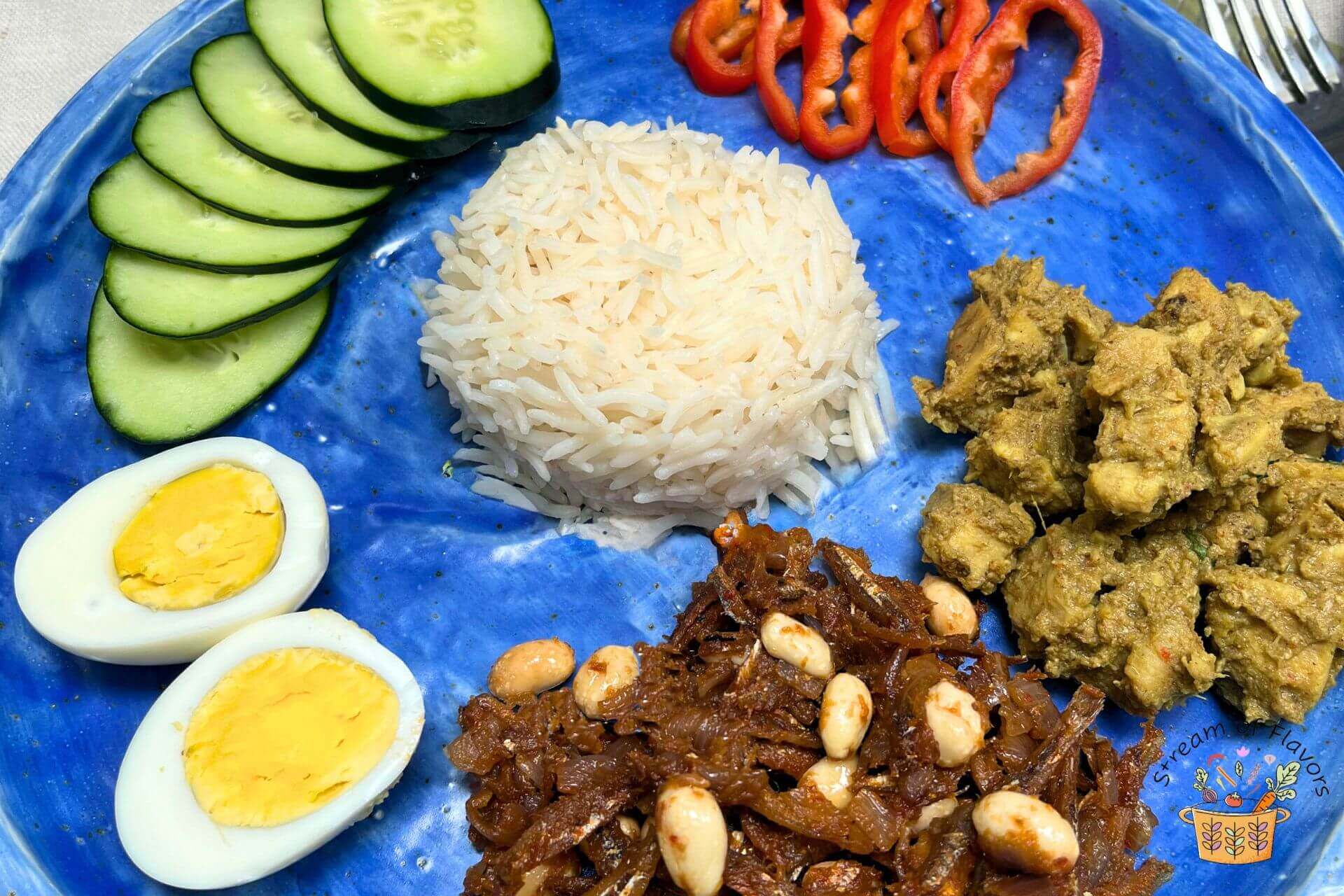
Ingredients:

- For the rice: white rice, fresh coconut milk (or canned coconut milk), and fresh or frozen pandan leaves (screwpine)
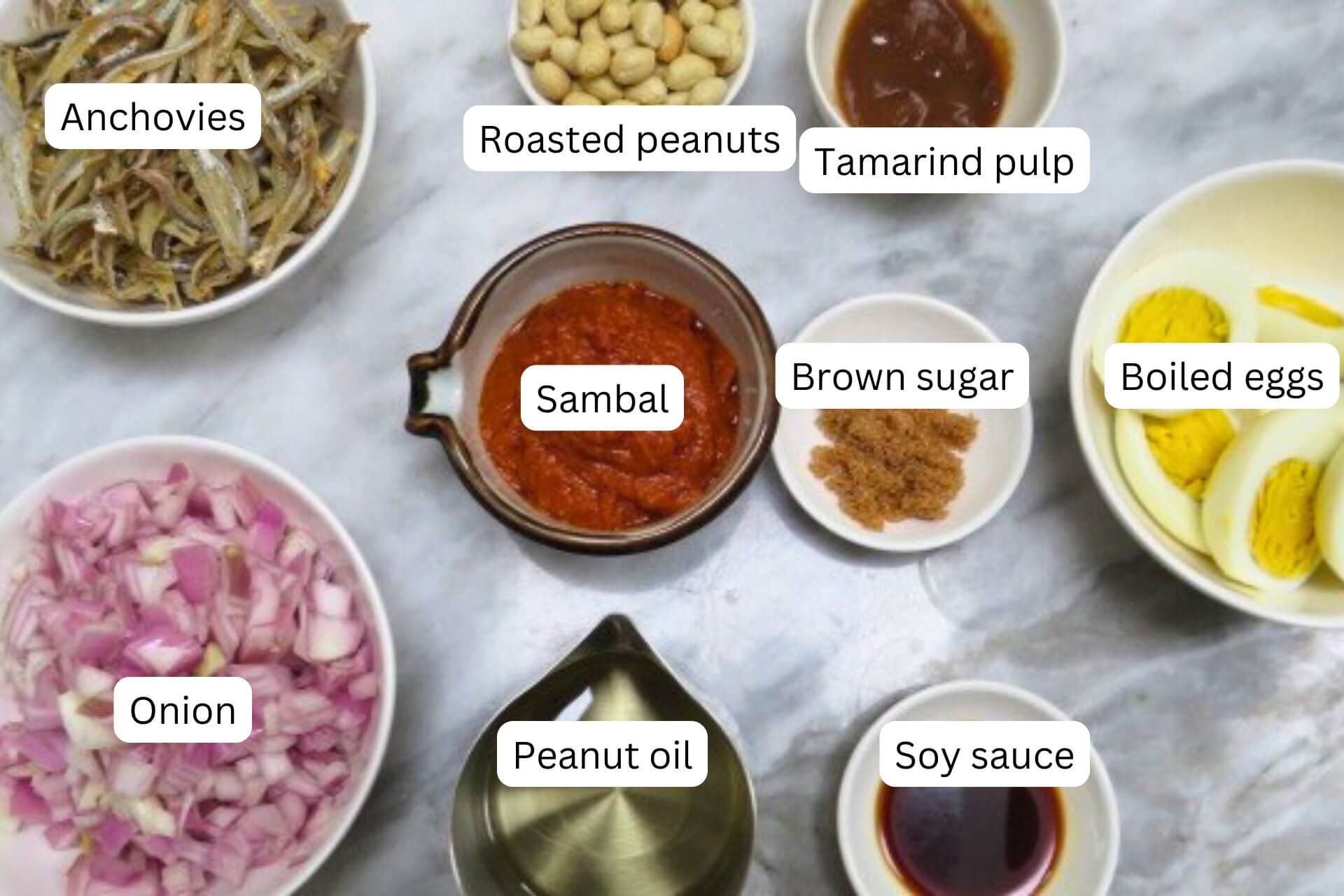
- For the ikan bilis: small dried anchovies or ikan bilis, onion, tamarind pulp, brown sugar, and soy sauce
- For the sambal paste: shallot, dried red chili, garlic and dried shrimp
- Other components: hard-boiled eggs, roasted peanuts, and sliced cucumber
Here are the step-by-step instructions on how to make this dish. Please refer to the recipe card below for the measurements.
How to make the Nasi Lemak using my recipe:
- Make the coconut rice:
- Mix the ingredients in the rice cooker and cook the rice. Keep it aside.

2. Make the sambal and fried ikan bilis:
Soak the ingredients in a bowl of water for 10 minutes. Grind them in a spice grinder using 1/2 tbsp of water or as needed to make a smooth sambal paste. Keep it aside. Heat a pan with peanut oil and shallow fry small batches of ikan bilis until crispy. Remove them using a slotted spatula and drain them on kitchen paper.

- In the same pan with the residual oil, sauté the onion for 4 minutes or until caramelized. Add the sambal paste and sauté for 2 minutes on medium heat.

- Add the soy sauce, brown sugar, fried ikan bilis, and peanuts and sauté for a minute. Turn off the heat and garnish with cilantro.

- Serve the Nasi Lemak with coconut-infused rice, ikan bilis with the sambal (topped with peanuts), hard-boiled egg, cucumber slices, and chicken rendang.

Tips:
- I prefer to use fresh coconut milk as it enhances the flavor of the rice.
- If you cannot find pandan leaves, feel free to use a few drops of the pandan essence.
- The spiciness of the sambal can be adjusted by adding more or fewer chilis in this Nasi Lemak recipe. Deseeding the chilis will reduce its heat.
Serving suggestions:
This recipe for Nasi Lemak is best served with a cup of coconut-infused rice with sliced cucumbers, boiled egg, ikan bilis sambal topped with peanuts, and chicken rendang. I have also served it with sliced peppers. Roasted peanuts can be put on the side or topped on the sambal.
Storage:
Nasi Lemak cannot be frozen but you could refrigerate the sambal paste in a glass jar and refrigerate it for 1-2 weeks. The sambal paste can be made ahead of time. Chicken Rendang can be frozen in airtight freezer boxes for three months.
Other sambal-based recipes that you might like:
Nasi Lemak Recipe
Equipment
- pan, stovetop
Ingredients
For the fragrant rice:
- 2 cup rice
- 1 cup coconut milk
- 2 cup water
- 1 pandan leaf (screwpine)
- ¼ tsp salt
For the sambal paste:
- 3 dried red chili deseeded
- 4 clove garlic
- 1 shallot
- 1 tbsp dried shrimp
For the sambal:
- 2 tbsp peanut oil
- 1¼ cup ikan bilis (small anchovies)
- 1 onion
- 1 tbsp tamarind pulp
- 1 tsp brown sugar
- 2 tsp soy sauce
- 2 tbsp peanut roasted
- 3 sprig cilantro for garnish
For the sides:
- 1 cucumber sliced with skin
- 4 egg boiled, sliced
Instructions
To make the rice:
- Prepare the ingredients. Use fresh or canned coconut milk. Boil the eggs and shell them.
- Mix the ingredients in the rice cooker and cook the rice. Keep it aside.
To make the sambal and fried ikan bilis:
- Prepare the ingredients.
- Soak the ingredients in a bowl of water for 10 minutes. Grind them (after draining the water) in a spice grinder using 1/2 tbsp of water or as needed to make a smooth sambal paste. Keep it aside. Heat a pan with peanut oil and fry small batches of ikan bilis until crispy. Remove them using a slotted spatula, and drain them on kitchen paper.
- In the same pan with the residual oil, sauté the onion for 4 minutes on medium heat or until caramelized. Add the sambal paste and sauté for 2 minutes.
- Add the soy sauce, brown sugar, fried ikan bilis, and peanuts and sauté for a minute. Turn off the heat and garnish with cilantro.
- Serve the Nasi Lemak coconut-infused rice with ikan bilis and sambal (topped with peanuts), hard-boiled egg, cucumber slices, and chicken rendang.
Video
Notes
- You can omit the chicken rendang from the Nasi Lemak recipe. Fried ikan bilis with sambal, peanuts, and boiled eggs served with coconut rice are essential.
Nutrition


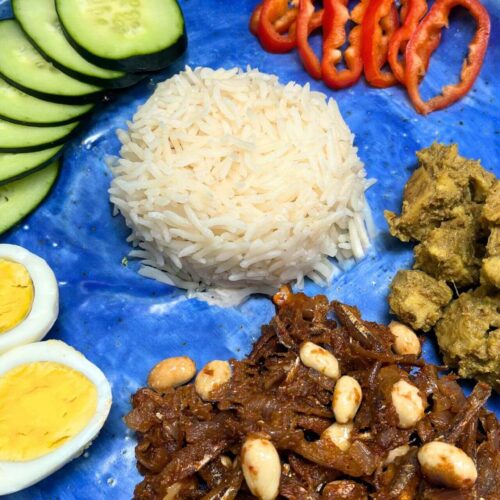
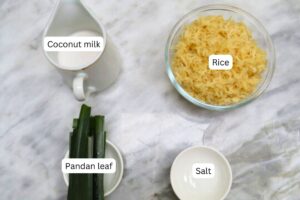
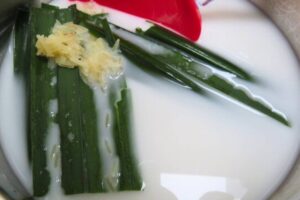
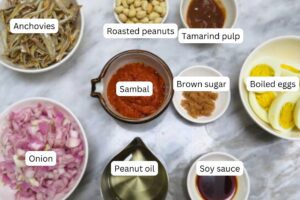


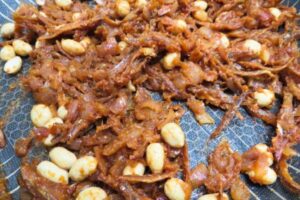
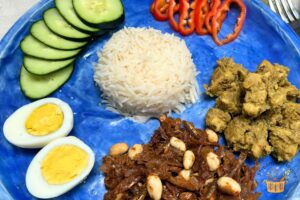




















0 Comments